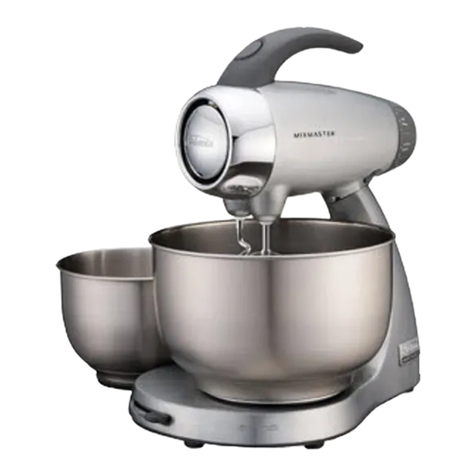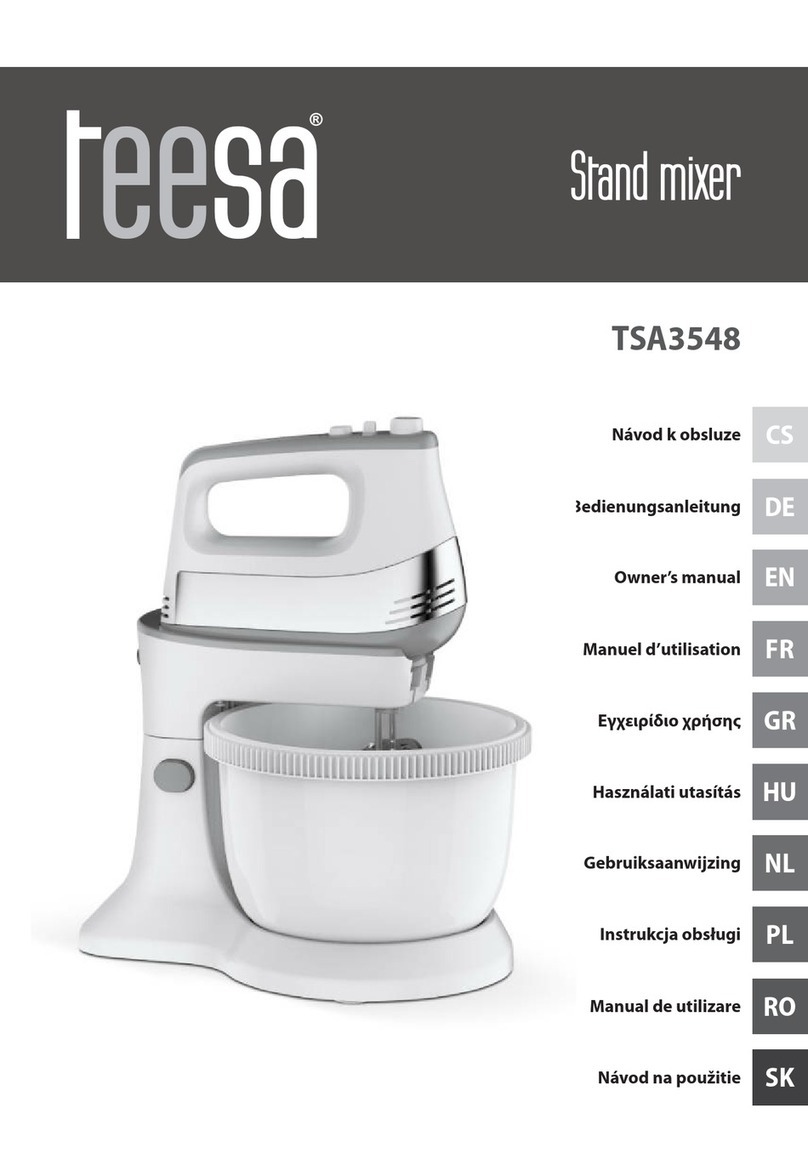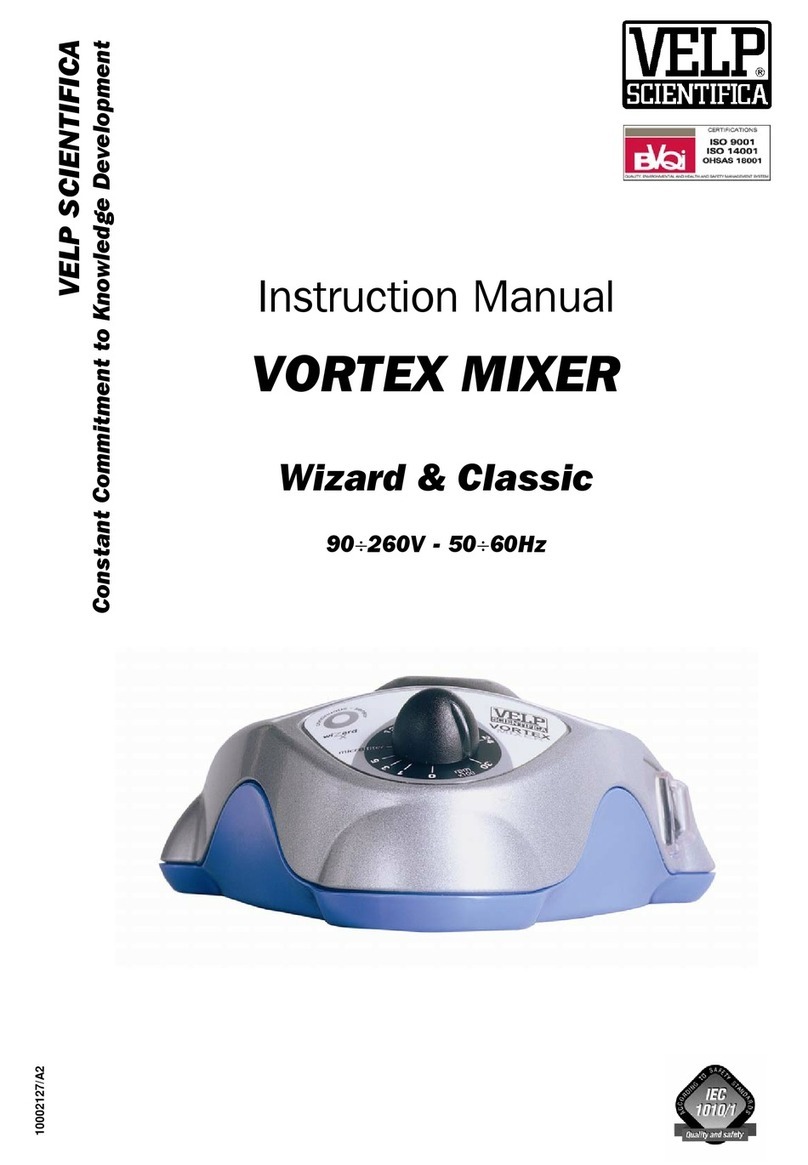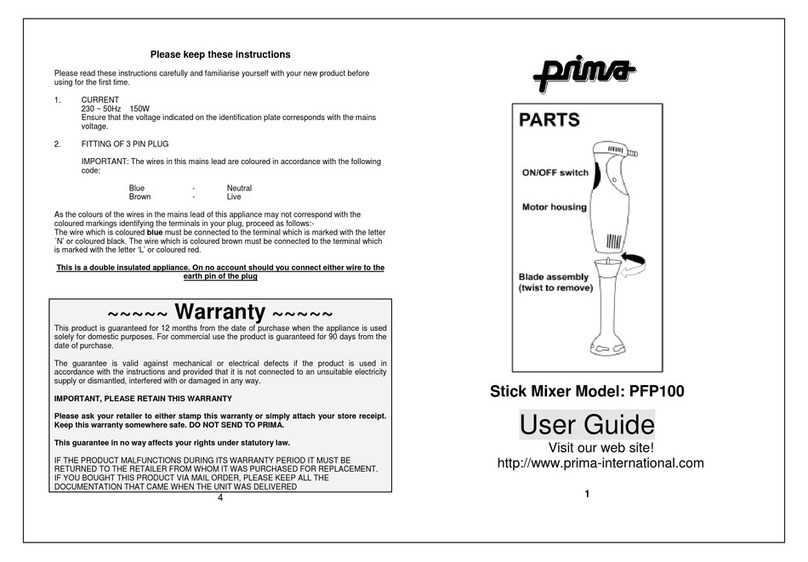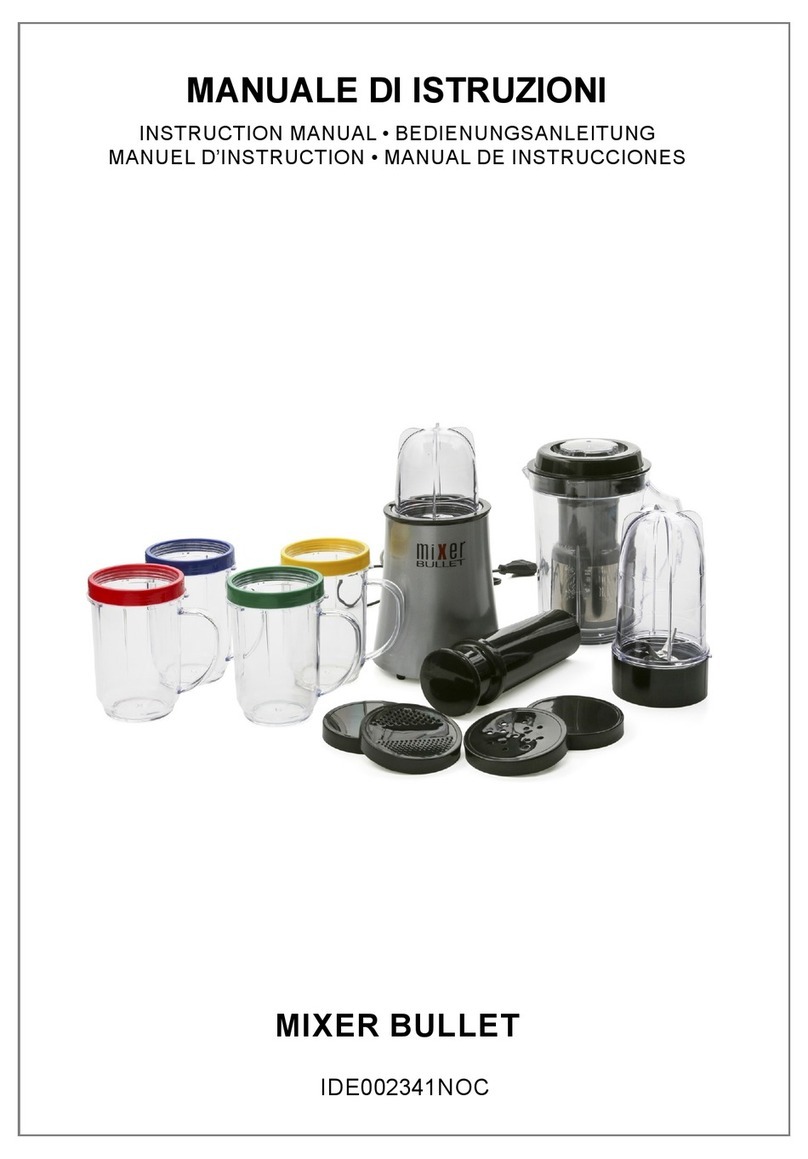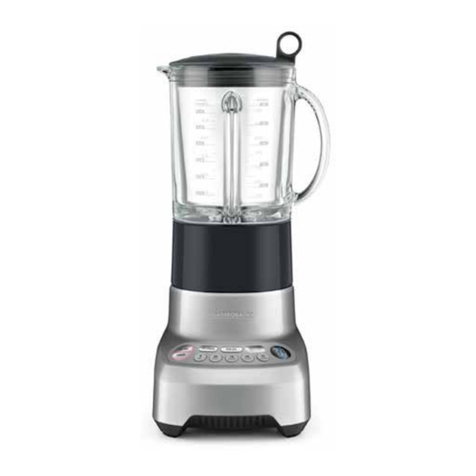Gastro STMF60 User manual

1
GGM Gastro International GmbH
Weinerpark 16
48607 Ochtrup
www.ggmgastro.com
Tel.: +49 (0) 2553 / 72 200
Fax: +49 (0) 2553 / 72 20 200
E-Mail: info@ggmgastro.com
Spiral Mixer
STMF
USER MANUAL

2
DECLARATION
We GGM Gastro International GmbH
Weinerpark 16
48607 Ochtrup
declare in sole responsibility that the device
Designation
Spiral Mixer
Model
STMF
Serial number
Construction year
to which refers, with the CE:
- 2014/35/CE Low Voltage Directive
- 2014/30/CE Electromagnetic Compatibility
- 2006/42/CE Machinery Directive
and complies with the mandatory provisions of the guidelines.

3
CONTENT
1 SYMBOLS AND PERSONAL QUALIFICATION 5
2 IDENTIFICATION OF THE MACHINE 6
3 SAFETY INSTRUCTIONS 7
4 RISKS, PROHIBITIONS, COMMITMENTS 9
5 DESCRIPTION OF THE MACHINE AND ITS USE 10
6 MAINTAINING THE MACHINE 11
7 UNPACKING THE MACHINE 12
8 HANDLING THE MACHINE 13
9 INSTALLING THE MACHINE AND POSITIONING THE OPERATOR 14
10 ELECTRICAL SYSTEM 16
11 CLEANING THE MACHINE 17
12 PROCEDURES IN OPERATION 18
13 REGULAR INSPECTION, CLEANING AND MAINTENANCE OF THE MACHINE 20
14 PROBLEM SOLVING 24
15 DISMANTLING AND DISPOSING THE MACHINE 25

4
Appendix
Appendix 1 The control panel as well as the programming of a duty cycle
Appendix 2 Technical characteristics and packaging
Appendix 3 Wiring Diagrams
Appendix 4 Exploded View and Parts List
REMARK
(i) The technical data are not binding. The data can be changed to improve the product.
(ii) Drawings and illustrations are for guidance only.
These operating and maintenance instructions are an important part of the machine. It must be kept for
the life of the machine and passed on to potential subsequent users. The instructions include all
instructions necessary for the transport, installation, commissioning, use, maintenance and disposal of
the machine and must therefore be read and understood before commencing any of these operations. It
must be handled with care and stored there where it is readily available for later questions from the
operators and technicians. Compliance with the contents of the operating instructions ensures safe,
correct and optimal operation of the machine as well as the safety of the machine operator and other
authorized persons who come into contact with the machine.

5
1 SYMBOLS AND PERSONNEL QUALIFICATION
The person responsible for the safety in the company and in the production department, when selecting the machine
operator, must choose someone who is suitable for the activity according to local laws, as well as the training of the
person and their mental and spiritual State (stability, sense of responsibility, etc.). Furthermore, the personnel
assigned to operate the machine must be properly trained (based on personal suitability and performance). This
includes the full understanding of these instructions to ensure that the operator knows the machine, its functions and
behavior, and how to perform each operation to ensure that the machine operates safely.
The following table shows the symbols and the associated necessary qualifications for the operating personnel on the
system. These are used throughout the tutorial to specify the qualifications required to complete a particular task.
Description
Characteristic / Qualifications
MACHINE OPERATOR
A person in good health who has been properly trained to operate the machine
(for example, it has good knowledge of: the machine functions, the machine
guidelines, the safety devices and guards installed on the machine, the possible
working cycles, the programming of working cycles, type the usable ingredient as
well as the maximum permitted amounts of ingredients). The person must have
carefully read and understood this manual for the purpose of using and
maintaining the machine.
ELECTRICAL ENGINEER /
TECHNICIAN SERVICE
A person in good health with an electrical engineering qualification who must
have carefully read and understood this manual for the purpose of using and
maintaining the machine.
MECHANIC / TECHNICIAN
SERVICE
A person in good health with an electrical engineering qualification who must
have carefully read and understood this manual for the purpose of using and
maintaining the machine.
PERSON RESPONSIBLE
FOR MATERIAL AND
EQUIPMENT HANDLING
A person in good health with an electrical engineering qualification who must
have carefully read and understood this manual for the purpose of using and
maintaining the machine.
CUSTOMER SUPPORT:
C / O of the manufacturer
Takes care of the following requests regarding:
•Updates to the manual
• telephone assistance regarding machine functions, Commissioning and errors
•spare parts
•engine repairs
•migration
Note: This machine must not be operated by persons with electronic implants (eg cardiac pacemakers),
nor may these persons intervene in the machine functions.
Warning and Description
Security label / Symbol
This symbol indicates the presence of live parts. Before performing any action on
the machine, disconnect the machine from the power supply by turning off the
main switch and ensuring that the machine's electrical panel and power cable are
safely disconnected from the main power supply for the entire duration of the
action without the machine being disconnected accidental risk of power
reconnection by the power supply.

6
2
DENTIFICATION OF THE MACHINE
Machine corresponds CE-Standards
A nameplate, similar to the one above, is located on the back of the machine. It contains:
• conformity type (CE)
• Details about the manufacturer
• Machine Type
•Serial number
• year
• Voltage, frequency and number of phases
• total power consumption (kW)
• Max. Flour
The electrical characteristics (voltage, frequency, number of phases and power consumption) are given in this manual in
the section "Machine Specifications" and in Appendix 2 and on the nameplate of the machine.
The weight and dimensions of the machine (with and without packaging) are also specified in this manual (see Appendix 2).

7
3
SAFETY INSTRUCTIONS
The mandatory safety measures that must be taken for the safe use of the machine are listed below. The
symbols and signs that appear in the various sections of the manual show the required qualifications of the
persons assigned to specific tasks and the corresponding risk level. The plant manager is personally responsible
for training appropriately qualified personnel assigned to a specific task.
Safety measures
•The space around the machine and associated equipment must be well lit, clear and clean.
• The personnel assigned to operate the machine must be physically fit and mentally stable and wear appropriate
clothing (anti-slip safety shoes, tight-fitting buttoned sleeves, gloves, mask and goggles appropriate to the needs of
the assigned activity). It is strictly forbidden to wear loose-fitting clothing, materials or accessories (ties, torn clothing,
open jackets, loose pieces of material, etc.) to prevent the risk of pinching.
Note: This machine must not be operated by persons with electronic implants (eg cardiac pacemakers), nor should
these persons intervene in the machine functions.
• It is necessary to take into account the maximum kneadable amount of dough for the machine, which may vary
depending on the percentage of ingredients used.
• Before performing maintenance and cleaning, personnel assigned to the task must turn off the main switch and
disconnect the machine from the power supply to ensure that the machine's electrical panel and power cord are
safely disconnected from the main power supply for the duration of the action without the risk of re-energizing.
• The service technician must wear protective clothing suitable for carrying out the task. The clothing must provide
protection against organic, chemical, biological, mechanical and / or electrical hazards.
• When working with the machine, it is always necessary to observe the safety warnings and signs on the machine
itself, within the working environment and on the products used, which may, for example, indicate the following:
-electric, mechanical or thermal risks
Risk of slipping on wet or greasy surfaces
-Risk of allergies to substances or irritations resulting from products used during the production process or cleaning
operations.
Failure to observe the safety warnings and signs may result in minor or major injury.
Safety devices
The machine is equipped with safety devices that protect both the operator and the machine itself. Under no
circumstances may these be removed, manipulated or altered in any way. It is necessary to regularly check
their functionality.
• Main switch (external): When switched off, it interrupts the power supply of the machine and thus allows the
absolutely safe execution of maintenance measures.
• Thermal overload switch (internal): Disconnects the power supply to the motor in case of electrical overload.
• Emergency stop switch (external): Disconnects the power supply to the machine, thus guaranteeing complete
safety of machine and operator.
• Fixed protective covers (external): All fixed covers (fastened with screws or mechanical blocks) protect against
heat and must not be removed. An exception to this is the performance of maintenance by suitably qualified
personnel, which must be performed in the specified manner and in accordance with safety standards in force. After
all maintenance, all protective covers must be correctly repositioned and securely fastened before the machine is
returned to service.
• Mobile bowl protection cover (external): Opening the mobile bowl protection cover activates the microswitches,
which interrupt the machine's functions and allow it to continue operation only when the mobile protection cover is
closed again.
Note: When one of the security systems is activated, it will not take more than 4 seconds for the spiral and
bowl to stop spinning. This time interval is based on the inertia. An immediate stop would cause mechanical
stress and fatigue fractures.

8
Accident prevention
Before starting the machine:
Please read this manual carefully. Make sure that there are no children, animals or unauthorized persons near the
machine. Carefully check that the machine and external safety devices are working properly.
During machine operation:
Never leave the machine unattended. Pay attention to unusual noises or unusual machine behavior. Keep away
from moving parts. Never open the mobile protective cover until the spiral tool has come to a complete stop.
After completing a work cycle:
Remove the contents of the bowl completely. Turn off the main power switch and disconnect the machine from the
power supply to ensure that the machine's electrical panel and power cord are safely isolated from the main power
supply for the full duration of the action without the risk of reconnection with the power supply consists. Clean the
machine according to the measures specified in this manual.
Machine tests performed by the manufacturer
The manufacturer will conduct a test series prior to placing the machine on the market to ensure that the
machine is functioning correctly:
• Function tests to check the electrical system and grounding.
• Function tests to check the mixer function.

9
4
RISKS, PROHIBITIONS, COMMITMENTS
It is forbidden to extinguish
fires with water.
It is forbidden to operate the machine
before checking the safety devices.
It is forbidden to clean the machine in
the presence of moving parts.
It is imperative to disconnect the machine from the power supply before performing any action on the
machine itself. Especially:
Disconnect the machine from the power supply to ensure that the machine's electrical panel and
power cord are safely isolated from the main power supply for the entire duration of the action
without the risk of re-energizing the power supply.
The machine must be earthed.
ATTENTION!
• Wear correct protective clothing for all measures.
• Clean the machine carefully; The products used during the
production process can cause allergies or infections.
• Do not place heavy or dangerous objects on the machine.
• Do not insert any objects or accessories through the opening of
the bowl protection cover.
• Do not remove safety devices and protective covers.

10
5
DESCRIPTION OF THE MACHINE AND ITS USE
Intended use of the machine
The product line of this spiral mixer is designed for kneading dough from the food industry, whose main ingredients
are flour and water. A rotating spiral mixes, mixes, refines and kneads quickly and easily through the powerful
mechanical work of the mixer, injecting air into the dough contained in the bowl. Originally intended for the preparation
of bread dough, the blender was subsequently also found to be suitable for sourdoughs and bakery products
consisting of the following ingredients: any kind of flour, yeast, fats / butter, sugar, officially approved food flavors and
food colors, salt, liqueurs and other ingredients suitable for bread and confectionery products. The mixer line is not
suitable for mixtures with a moisture content of less than 55%. The maximum time interval for continuous use and the
corresponding minimum downtime for this mixer differ depending on the recipe used (type of dough to knead);
Therefore, the user must contact the manufacturer for this information with the recipe.
Percentage of ingredients
Based on the percentage of each ingredient, there is a maximum amount of each ingredient that can be added to the
bowl so as not to exceed the maximum amount of dough specified for the blender.
For additional information about the maximum amount of dough and the percentage of flour for a particular mixer, see
Appendix 2.
Machine structure
The mixer consists of the following components:
• A durable stainless steel body (reinforced with metal profiles at locations where mechanical stress is greater)
incorporates and supports the various machine components.
• The upper drive group (seated under the head cover) turns the spiral. This movement is generated by a durable,
forged shaft mounted on a ball-bearing flange.
• The spiral mixes and refines the ingredients by their shape and movement by pushing them against the column and
sides of the bowl.
• Due to its movement, the bowl ensures that the dough is continuously kneaded under the spiral.
• The control panel located on the head cover contains the control and program logic. It performs every programmed
duty cycle and drives the various motors in a programmed manner for a programmed time due to the servos of the
electrical panel.
• The lower drive group (seated inside the base plate) turns the bowl. This movement is generated by a durable,
forged shaft mounted on a ball-bearing flange.
• The safety covers of the bowl and the upper and lower drive groups (invisible due to the seat under the base plate)
protect persons from accidental contact with the moving parts of the machine.
• The mobile safety cover stops the machine via a microswitch when opened during a work cycle.
AThe minimum opening of the mobile safety cover required to activate the microswitch is set by the
manufacturer at the place of manufacture during the machine check. Any subsequent modification of
the manufacturer's original settings may only be carried out by personnel authorized by the
manufacturer.
General machine operation
After proper installation of the machine, it is necessary to select the required working cycle (eg the operating mode
and the corresponding operating times - see Annex 1). Put the water, flour and other ingredients necessary for the
dough in the required quantities in the bowl (do not exceed the maximum permitted - see Appendix 2). Lower the
mobile bowl cover and start the machine by pressing the start button. The machine goes through the work cycle in the
selected manner for the time previously set. It is possible to stop the machine at any time by pressing the stop button
and to restart it by pressing the start button. The control panel and its use are described in detail in Appendix 1.

11
6
MAINTAINING THE MACHINE
Maintenance of the machine before prolonged non-use
• Disconnect the machine from the power supply.
• Clean the machine thoroughly.
• Protect the machine against atmospheric influences, dust and dirt.
Storage of the packed machine
The machine must be stored in a hygienically clean, enclosed and covered environment as well as on a flat and firm
surface, protected from atmospheric influences, dust and dirt.
The ambient temperature must be between -20 and +40 ° C, the humidity must not exceed 90%.
Storage of the unpacked machine
If the machine has already been unpacked, it must be lifted off the ground (attached to a suitable pallet or other secure
platform) in addition to the above conditions and carefully covered to protect it from moisture, dust and dirt. If the
machine is wrapped in cellophane or other plastic film, it is absolutely necessary to ensure that it is not completely
sealed to avoid corrosion due to condensation. If possible, keep the original packaging.
ATTENTION! It is strictly forbidden to store the machine outside!

12
7
UNPACKING THE MACHINE
As shown in this figure, the machine is delivered standing on a wooden pallet (item A) and is held in
position (item C) by two vertical bars (item B) and one transverse bar.
C
B
A
Machine always stands on a pallet and be packed in a wooden crate.
The information regarding the gross weight is on the outside of the packaging.
To unpack the machine, it is first necessary to remove the outer packaging material, then the two vertically fitted strips
from the plate and finally the transverse strip.
All packaging materials, except vertical and transverse strips, can be recycled or disposed of as conventional residual
waste in accordance with local waste disposal laws.

13
8
HANDLING THE MACHINE
When lifting and / or moving the machine, it is essential to follow the instructions in this section, all
safety instructions and local safety standards as well as guidelines in force.
ATTENTION! Before carrying out a transport operation, check the total weight of the machine with and without
Packing and use accordingly, appropriately, correctly positioned equipment around the packed / unpacked
Lift the machine according to the procedure specified below.
Lifting the packaged machine (with a forklift or
pallet truck)
• Retract the forks into the pallet as shown in the following illustrations.
• Primary handling instructions for the device:
• Make sure the lifter is suitable for the load being transported.
• Open the lift forks to the required width to position them correctly
without damaging the pallet and / or the machine itself.
• Place the forks in barycentric position. This does not always
correspond to the center of the packaged machine.
• Before lifting the packaged machine, make sure that the ends of the
forks protrude from the pallet.
• When moving the machine, keep it near the ground.
• Make sure that the area where the load is moved is free of objects,
people and animals.
• suitable protective clothing.
Manually moving the unpacked machine
ATTENTION! Before moving the machine in any way, make
sure it has been disconnected from the power supply (by turning
off the main power switch and disconnecting the power plug of
the machine from the power outlet).
The unpacked machine can be moved manually thanks to the
rollers mounted below the machine. When the machine is
moved this way, follow these precautions:
• The machine must be moved slowly and carefully.
• The machine may only be moved over flat, level and solid
surfaces without any output level changes.
The machine rests on four rollers: two rotating rollers (B) on the
back and two rotating roller (A) on the front. The machine can be
moved manually by turning up the auxiliary screw (C).. This
procedure is useful for moving the machine under it to clean the
surfaces.

14
9
INSTALLING THE MACHINE AND POSITIONING THE OPERATOR
Operating conditions
Environmental Conditions: The machine must be installed on a firm and level surface within a well-lit and
ventilated building. The ambient temperature must be between 5 and 40 ° C, the humidity must not exceed 90%.
Lighting: The light available to the operator of the machine must be suitable for the type of work to be done and
in accordance with current legislation. The lighting must be sufficient to clearly read the machine controls and
warning / danger signs without dazzling the operator.
Vibrations: If the machine is used correctly, the vibrations generated during operation of the machine pose no
danger.
Electromagnetic Interference: The machine described in this manual has been designed to operate correctly in
an industrial electromagnetic environment.
Cleanliness of the working environment: The machine may only be used in environments suitable for the storage
and manufacture of food products. Furthermore, it is necessary to comply with the following operating conditions:
• No ventilation during filling with ingredients and during the start-up phase of the work cycle (mixing
ingredients) to prevent over-appearance of food powders.
• Use of containers and tools suitable for handling food products.
Positioning of the machine and the operator
500
500 500
Carefully choose the location of the machine on site. Make sure that the floor is level and that there is enough room for the
operator to simply fill in the ingredients and remove the kneaded dough. Furthermore, there must be sufficient space around the
machine for cleaning and maintenance (see illustration above).
The machine is designed for use in bakeries and pastry shops, and thus for environments with widely varying
temperature and humidity (as described in the upper section Environmental Conditions).
Avoid excessive ventilation of the working environment, which can lead to meal discharge during filling and
during the starting phase of the working cycle.
The illustration above shows the correct positioning of the operator on the machine.

15
Attach the set up machine
Machine stability
The machine must stand on a horizontal, smooth, solid surface with no initial level changes. Once the machine has
been correctly positioned at the selected location, it must be stabilized by simply adjusting the leveling feet (C) on the
ground until the front rotating wheel s(B&A) is lifted off the ground and the machine is stable and level. Use a spirit
level to check if the machine is upright.
B C

16
1 0
ELECTRICAL SYSTEM
Connection to the power supply
ATTENTION! Make sure that the voltage (V), frequency (Hz) and number of phases of the power supply match
the specifications on the machine nameplate and the motor. An incorrect connection will damage the machine
and void the warranty.
Connect the power cable (D) to a power outlet that has all the required characteristics (as specified in the
machine specification sheet in this manual).
Turn on the main switch.
Disconnect the machine from the power supply
First turn off the main power switch and then the switch socket before pulling the plug out of the socket.

17
1 1
CLEANING THE MACHINE
The machine was designed for the production of food products. Thus, it is essential that it is completely
cleaned and disinfected daily, according to local disinfection requirements for food processing environments.
Cleaning the machine body
This must only be cleaned with a damp cloth that has been soaked in water and sufficiently wrung out. The cloth must
be selected and disinfected according to the local disinfection requirements for food processing environments. It is
strictly forbidden to use cleaning items that can scratch or damage the machine.
Cleaning the inside of the bowl and mixing tools
Remove any dough residue with a suitable tool that will not scratch or damage the inner surface of the bowl and
mixing tools. Use water and, if necessary, a food-grade soap to clean the bowl. Rinse the bowl completely. Disinfect
the bowl according to local disinfection requirements for food processing environments.
Cleaning the surface below the machine
The machine is equipped with rotating rollers which allow the machine to
be moved manually to make the area below the machine easily accessible
and therefore cleanable.
•ATTENTION! The machine can be moved manually by turning up the auxiliary
screw(C)

18
1 2
PROCEDURES IN OPERATION
ATTENTION! Strict compliance with the safety measures and local safety standards specified in this manual is
essential for carrying out all work with the machine.
• Preparatory machine check
• Check the following before starting the work cycle:
• The machine is stable on a straight, smooth and solid surface.
• The machine is correctly connected to the power supply.
• The machine parts are clean.
A
Fill in the ingredients to be kneaded
With the machine off, it is possible to gain access to the bowl by simply lifting
the mobile bowl protective cover (A).
Check that there are no foreign objects in the bowl and it is clean. Put the
ingredients (only products that are suitable and approved for the production of
bread and confectionery products) in the bowl. Observe the maximum
quantities permitted for the corresponding machine (Appendix 2).
The recommended order for filling the ingredients is as follows:
1. Dispatch the required amount of water into the bowl.
2. Put the flour into the bowl(in correct proportion to the water).
3. Then add other ingredients for the dough (salt, raising agent, butter,
margarine, etc.) by lifting the mobile bowl protective cover and placing
the ingredients in the bowl. If the mobile bowl cover is raised while the
machine is in operation, the machine will stop. It is therefore necessary
to close the mobile bowl cover and restart the machine to complete the
cycle. Add small amounts of ingredients to the dough by adding them
directly through the opening (s) in the mobile bowl cover without
opening the lid itself.
The operator is strongly advised to add the flour to the bowl after filling with water, otherwise the dough will
form high-density lumps which will cause the machine to function irregularly resulting in a sudden increase in
performance which will shorten the life of the drive belts and generally causes the wear of wearing parts.
Performing a work cycle
It is only possible to start the machine when the mobile bowl protection cover (A) is closed.
Appendix 1 contains a detailed description of the control panel, its functions and how to program and execute
a work cycle.
All machine commands required to complete a work cycle are
located on the control panel.
• The start button starts the set work cycle.
• The time countdown of the performed duty cycle is displayed on
the control panel's digital display or LED (depending on the type of
control panel).
• If the mobile bowl protection cover is opened, the duty cycle will be
interrupted. To continue the work cycle, put down the cover again.
• The Stop / Emergency Stop button stops and resets the duty cycle.
The time display returns to the initial setting of the last executed
duty cycle.

19
Warnings regarding repeated interruptions to a work cycle
Once the cycle has been started by pressing the start button, the machine continues to knead the dough until the
set working time has elapsed unless the operator breaks the cycle. Avoid repeated interruptions to the duty cycle,
as this will overheat the engine, which may affect the machine's efficiency in the long term.
Stopping the machine
The timers automatically stop the work cycle and thus the machine as soon as a programmed time has elapsed.
The machine can be stopped at any time by pressing the STOP / EMERGENCY button. Nevertheless, it is
strongly recommended to avoid repeated interruptions by the operator. To turn off the machine, turn the main
switch to the "O" position.
Remove the kneaded dough
After completion of the working cycle, it is possible to remove the dough after opening the mobile bowl protective
cover from the bowl. It is strictly forbidden to use objects that can scratch or damage the machine.

20
1 3
REGULAR INSPECTION, CLEANING AND MAINTENANCE OF THE MACHINE
ATTENTION! Prior to performing any periodic inspection, cleaning or maintenance, turn off the
machine by turning the main power switch to the "O" position and disconnect the machine from
the power supply to ensure that the electrical panel and power supply cable of the machine are
in good condition Machine are safely isolated from the main power supply for the entire
duration of the action without the risk of re-energizing the power supply.
Cleaning procedures and regular inspections
The first and most efficient form of preventative maintenance is to keep the machine clean.
Regular and complete cleaning prevents the accumulation of dough residues, which can
damage moving parts in the long term.
Before performing any inspection or cleaning, the operator must:
• Wear protective clothing suitable for carrying out the tasks. The clothing must provide
protection against organic, chemical, biological, mechanical and / or electrical hazards.
• switch off the machine and disconnect it from the power supply.
Daily cleaning procedures and inspections:
• Clean the bowl, spiral, pillar and fixed and mobile bowl guards as described in section
Cleaning the Machine.
• Carefully check visually that the machine and external safety devices are working properly
(described in the Safety Instructions section).
Inspection of safety devices
The safety devices installed on the machine must be checked regularly.
Legend of the inspection frequency
(FREQUENCY)
Legend of the inspection work to be carried out
(ART)
d = daily
O = Observation: Visual inspection (eg check the correct
function of the alarm lamps / LED)
E = Execution: An action is necessary to check the reaction (eg
the machine must stop when the emergency stop button is
pressed)
M = Measurement: The inspection requires instruments to
measure values to be checked (eg grounding values).
w=weekly
m = monthly
a = annually
Main switch
Purpose: Disconnect the power supply
Function: This component disconnects the machine from the power supply. Turn them into
different positions and make sure that they work correctly in each position. Turn off the main
switch and check that no current is flowing.
Lamps on the control panel
Purpose: Representation of the machine status
Various functions of the machine have a corresponding lamp, which lights up when the function is
activated. The lamps are not necessary for the machine functions, but they indicate the machine
status (eg when performing a task) and therefore play an important role in the safe use of the
machine.
Activate each machine function and check that the associated lamp is lit.
Stop emergency stop circuit
Purpose: Deactivation of all machine functions
Pressing the red mushroom-shaped emergency stop button cuts off the power to all machine
electrical components and disables all machine functions. The executed machine function
stops in the position that it is at the time has reached the interruption, with the exception of
those parts which are subject to inertia (eg the spiral). To restart the machine, the emergency
stop button must be turned clockwise until it is no longer blocked.Check that the emergency
stop button works as described above.
Check
Frequency Art
a E
Check
Frequency Art
m O
Check
Frequency Art
mE
This manual suits for next models
4
Table of contents
Popular Mixer manuals by other brands

INOXPA
INOXPA 875 Series Installation, service and maintenance instructions

Omnitronic
Omnitronic LH-115 user manual

Topps Tiles
Topps Tiles 632499 instruction manual

Amersham Pharmacia Biotech
Amersham Pharmacia Biotech M-925 instructions
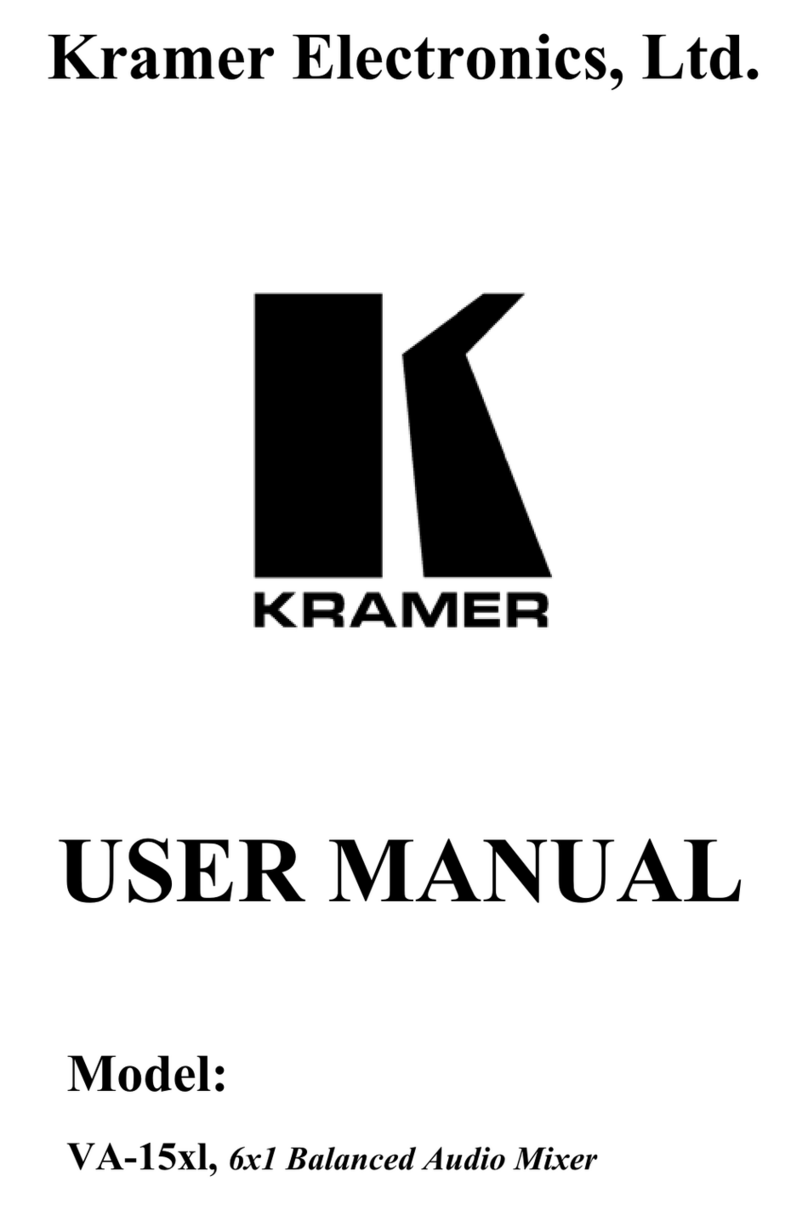
Kramer
Kramer VA-15XL user manual

KitchenAid
KitchenAid W10399721A instructions

